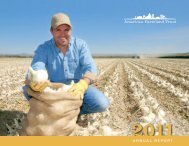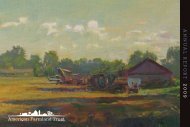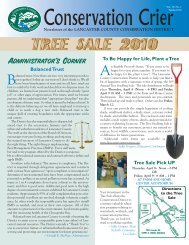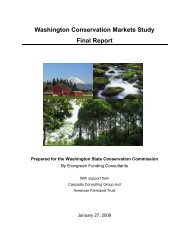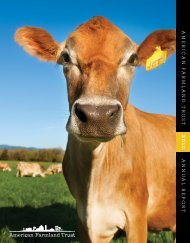Agricultural Landowners Guide Agricultural Landowners Guide
Agricultural Landowners Guide Agricultural Landowners Guide
Agricultural Landowners Guide Agricultural Landowners Guide
Create successful ePaper yourself
Turn your PDF publications into a flip-book with our unique Google optimized e-Paper software.
appointed board. Application deadlines are in March,<br />
July and October. <strong>Landowners</strong> interested in participating<br />
in this program should contact their local land trust<br />
to discuss the potential ranking of their property for the<br />
Conservation Bank’s priorities. <strong>Landowners</strong> can apply<br />
to sell either their entire property or just a conservation<br />
easement, after which they can retain traditional control<br />
of their land.<br />
For information, contact the South Carolina<br />
Conservation Bank.<br />
Estate Planning<br />
Many farmers and their heirs are challenged by farm<br />
transition and planning. Passing on the farm takes more<br />
than transferring the land from one generation to<br />
another. It requires good estate planning that accommodates<br />
the needs of all family members, even those who<br />
leave the farm, and that addresses issues such as retirement<br />
and disability. It also can include conservation<br />
options, such as agricultural conservation easements.<br />
A will is an important part of an estate plan, but does<br />
not secure the future of the family’s land and farm<br />
business. Good estate planning accomplishes at least<br />
four goals:<br />
• Transferring ownership and management of the<br />
agricultural operation, land and other assets;<br />
• Avoiding unnecessary income, gift and estate taxes;<br />
• Ensuring financial security and peace of mind for all<br />
generations; and<br />
• Developing the next generation’s management<br />
capacity.<br />
Heirs’ Property Preservation Project<br />
“Heirs’ property” is a form of passing along property<br />
so that ownership interest is equally divided among<br />
heirs, rather than splitting the property so that each heir<br />
is given his or her own piece. It occurs frequently when<br />
land is passed along without a will. This issue is particularly<br />
important in African-American communities,<br />
which have a strong tradition of heir property ownership.<br />
Originally intended to keep farms intact within a<br />
family, it can result in complicated, highly divided ownership<br />
after several generations. This makes decisions<br />
on taxes, planting and harvest, participation in conservation<br />
programs and land sales very difficult. It also<br />
makes the land vulnerable to unwanted partition sales,<br />
if one of the owners wishes to receive cash for his or<br />
her ownership share.<br />
The Heirs’ Property Preservation Project of the South<br />
Carolina Centers for Equal Justice can help you work<br />
through your heirs’ property concerns, including giving<br />
you a better understanding of this form of ownership,<br />
hazards that could result in the loss of your land and<br />
strategies for consolidating ownership among those<br />
family members with an ongoing interest in maintaining<br />
that land.<br />
For information, contact the South Carolina Centers for<br />
Equal Justice.<br />
Farm and Ranch Lands Protection Program<br />
The Farm and Ranch Lands Protection Program (FRPP)<br />
is administered by the USDA Natural Resources<br />
Conservation Service (NRCS) to provide matching<br />
funds to help purchase agricultural conservation easements<br />
on productive farm and ranch lands. Originally<br />
authorized as the Farmland Protection Program in the<br />
1996 Farm Bill, it became the Farm and Ranch Lands<br />
Protection Program in the 2002 Farm Bill. To qualify,<br />
landowners must work with state and local governments<br />
or non-governmental entities to secure a pending<br />
offer with funding at least equal to 50 percent of the<br />
land’s fair market easement value. The FRPP can provide<br />
the remaining 50 percent for qualified applications.<br />
Only parcels large enough to sustain agricultural production<br />
are eligible. With NRCS assistance, participants<br />
develop a conservation plan that outlines the management<br />
strategies that they propose to use on the enrolled<br />
land. The South Carolina<br />
NRCS accepts applications<br />
from eligible entities<br />
during the annual<br />
application window.<br />
For information, contact<br />
American Farmland<br />
Trust or the South<br />
Carolina USDA Natural<br />
Resources Conservation<br />
Service.<br />
Photo: Southern SARE<br />
Photo: courtesy USDA<br />
5


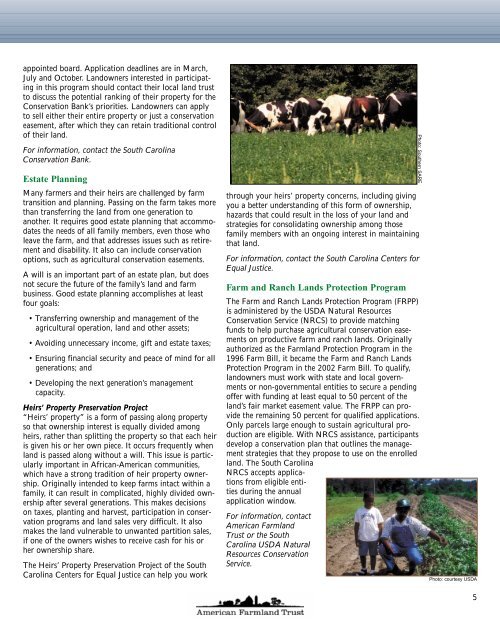
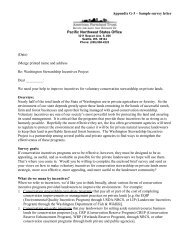


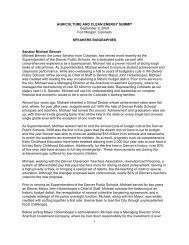
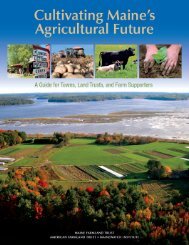
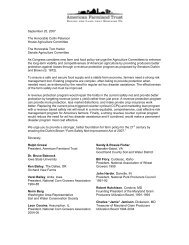
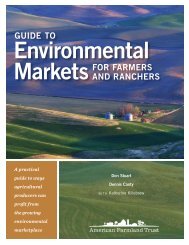
![Farmland by the Numbers [PDF] - American Farmland Trust](https://img.yumpu.com/31549391/1/190x245/farmland-by-the-numbers-pdf-american-farmland-trust.jpg?quality=85)
